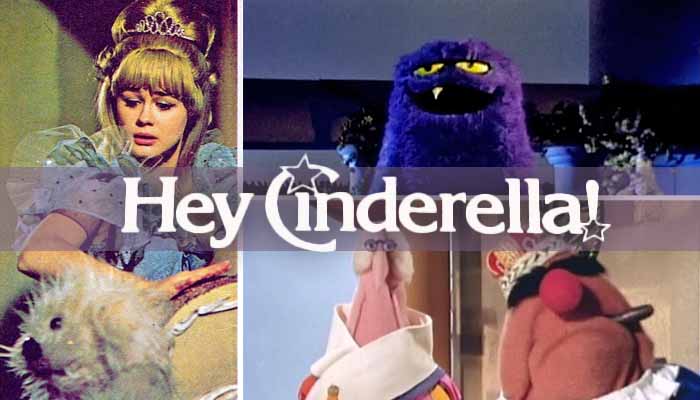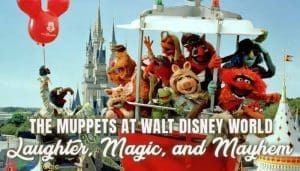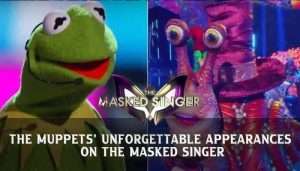Long before Sesame Street changed children’s television forever and The Muppet Show became a global phenomenon, Jim Henson was already weaving his unique brand of magic, blending puppetry, music, and gentle subversion into unforgettable viewing experiences. One of the earliest, and arguably most pivotal, examples of this burgeoning genius was the 1969 television special, Hey Cinderella!. While perhaps overshadowed by later Muppet triumphs, this charming, witty adaptation of the classic fairy tale wasn’t just another children’s program; it was a foundational moment for the Muppets, a crucible for creative partnerships, and the place where a certain iconic frog truly found his voice – and his flippers.
A Familiar Tale, With a Muppet Twist
At its core, Hey Cinderella! follows the well-trodden path of the beloved fairy tale, based on Charles Perrault’s version. We meet the lovely Cinderella (played by a human actress, Belinda Montgomery), enduring the drudgery imposed by her wicked stepmother (Pat Galloway) and dim-witted stepsisters (voiced hilariously by Muppet performers Frank Oz and Jerry Nelson). Her only solace comes from her loyal dog, Rufus. Meanwhile, at the palace, Prince Arthur Charming (Robin Ward) faces pressure to marry, though not from a particularly traditional source.
But this is where the Muppet magic kicks in, gently nudging the familiar narrative onto a delightfully skewed track. The impetus for the royal ball isn’t solely matrimonial duty; King Goshposh (performed by Jim Henson himself) is simply bored and declares, “I wish to throw a party so that I may be given presents!”. The wedding idea is merely a convenient excuse for gift acquisition. Prince Arthur, far from being eager, dreads meeting princesses he assumes are snobs; he longs for a girl who doesn’t know his title.
Their meeting is equally unconventional. Cinderella encounters Arthur in the gardens, not at a grand entrance, but while fulfilling a chore. He promptly introduces himself as a gardener to gauge her true character. This sets up a running gag about their respective suitability for different roles, with Cinderella later teasing, “Arthur, it’s lucky you’re a gardener because you’d never make it as a prince,” unaware she’s speaking to royalty.
The guest list expands beyond nobility when Arthur convinces his father to invite everyone in the land – the more guests, the more presents for the King. Their plan for Arthur and Cinderella to recognize each other at the masquerade ball via a geranium is comically thwarted when the King decides all guests should receive one.
Even the magical elements receive a humorous Henson touch. The Fairy Godmother (Joyce Gordon) is portrayed as endearingly inept, her spells frequently misfiring before she finally conjures the ballgown and iconic slippers. She explains the glass footwear as “the latest style, see-through footwear. Just remember to dance softly”. The transformation sequence is further complicated when the designated magical horses are scared off, requiring the intervention of a large, purple, shaggy monster named Splurge to pull the coach, driven by a rather reluctant frog.
The climax deviates too. At midnight, the Prince accidentally crushes the single glass slipper Cinderella leaves behind. The search becomes one for the owner of shattered glass. When Cinderella realizes she is the maiden sought, her initial desire is to marry Arthur the gardener, not the Prince. A final magical mishap sees the Fairy Godmother accidentally vanish Cinderella while trying to restore her ballgown, only for her to reappear just as Kermit and Splurge return the broken slipper found in Splurge’s radish patch (thanks to Rufus burying it there). The ending sees Kermit personally invited to the wedding (provided he brings a present for the King, naturally) before leaping into a well. This adaptation, while reaching the traditional happy ending, does so via a path filled with gentle satire, character-driven humor, and unexpected twists, making it feel distinctly Muppet.
Meet the Muppets (Some for the First Time!)
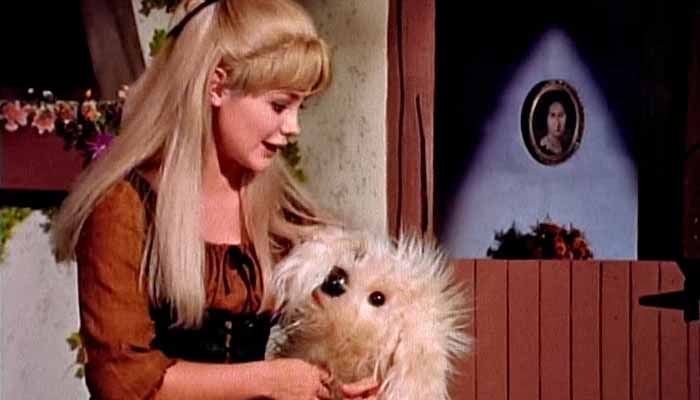
Hey Cinderella! is notable not just for its story but for its cast of characters, marking significant milestones for several beloved Muppets.
Leading the Muppet ensemble is Kermit the Frog, voiced by Jim Henson. Crucially, this special marks Kermit’s official debut as a frog. While he had appeared on television since 1955’s Sam and Friends, his design was initially more lizard-like, crafted from Henson’s mother’s old coat. For Hey Cinderella!, filmed in 1968, Kermit was specifically redesigned with his now-signature pointed collar (to hide the head-body seam) and flippers, solidifying his amphibian identity. His personality also shifts here, moving away from earlier, more mischievous iterations towards the pragmatic, slightly put-upon “voice of reason” that would become his hallmark. He serves as Prince Arthur’s confidante, offering sensible, if sometimes wry, advice (“It’s lucky you’re a prince because you’d never make it as a gardener”) and reluctantly agrees to be Cinderella’s coachman, though he draws the line at being magically turned human for the job. Some viewers even noted a slight New York inflection in his voice for this special, a subtle hint of the worldly-wise frog to come. This solidification of Kermit’s look and personality was a watershed moment, setting the stage for his eventual role as the heart and center of the Muppet universe.
Joining Kermit are characters repurposed from Henson’s earlier, unsold pilot projects, Tales of the Tinkerdee and The Land of Tinkerdee. King Goshposh, also performed by Henson, is the bored, avaricious monarch whose desire for presents sets the plot in motion. His interactions, like questioning his aide Featherstone about the frog-driven monster coach or debating invitation validity with the monstrous Splurge at the punch bowl (“Are you sure I sent you an invitation?… I’m not a frog…. You’ve got a point there.”), provide much of the special’s gentle absurdity.
Rufus, Cinderella’s loyal canine companion (performed by Frank Oz), also originated in the Tinkerdee projects. His role is significant as an early example of a Muppet portraying a mostly realistic animal. Unlike talking dogs like Rowlf, Rufus communicates primarily through pantomime and action, understanding human language but responding non-verbally. The effectiveness of this portrayal relies heavily on the believable chemistry between the human Cinderella and the puppet, making the audience accept Rufus as a real, albeit exceptionally clever, dog. His burying of the slipper in Splurge’s radish patch becomes a key plot point.
The special also introduced Splurge, a large, purple, furry monster performed by Frank Oz. Splurge holds the distinction of being the first full-bodied Muppet, a technical innovation allowing for more dynamic physical performance than traditional hand puppets. His presence adds to the visual humor, particularly when he takes over carriage-pulling duties after frightening the horses.
Rounding out the key Muppet cast are Featherstone (Jerry Nelson), the King’s long-suffering, beaky-nosed aide (an upgrade from the simpler Prime Minister character in Tinkerdee), and the Stepsisters (voiced by Frank Oz and Jerry Nelson), portrayed as comically inept. The way these Muppet characters interact primarily with the human leads, often serving as comedic foils or plot devices rather than driving the core emotional narrative, reflects an early stage in Henson’s exploration of integrating his creations into human-centric stories. This balance would evolve in later specials like The Frog Prince, where Muppets took on more central dramatic roles alongside humans , suggesting Hey Cinderella! was a valuable step in discovering the full narrative potential of Muppet-human interaction. Furthermore, the reuse of characters like Goshposh and Rufus from the Tinkerdee pilots demonstrates Henson’s characteristic resourcefulness, salvaging creations from unsold projects while subtly hinting at a larger, interconnected “Muppetland” where characters might cross paths – a precursor to the rich Muppet universe fans know today.
Behind the Magic – Crafting a Muppet Fairy Tale
The journey of Hey Cinderella! to the screen is a story of persistence and creative evolution. Its origins lie in a 1965 concept developed by writers Jon Stone and Tom Whedon (father of Joss Whedon). Initially envisioned as a Snow White series for CBS, the idea was passed over, then reworked as a Cinderella series pilot for ABC. This pilot, also involving Henson, Frank Oz, Jerry Nelson, and composer Joe Raposo, featured a unique concept: telling the story incrementally each week, ending on cliffhangers with unexpected twists (like the Prince crushing the slipper), and eventually integrating other fairy tale characters.
ABC ultimately passed on the series in 1965. However, Henson didn’t discard the idea. In 1968, he revived the concept, merging it with characters and ideas from his Tinkerdee projects to create the hour-long special Hey Cinderella!. Stone and Whedon received writing credits on the special, adapting their earlier work, and Raposo returned to compose the score, including the charming song “If I Could Go Dancing”. This marked the first major collaboration between Henson, Stone, and Raposo – a partnership that would soon prove world-changing.
The special was produced by Peter Miner, with Robert Lawrence as executive producer, and filmed in the fall of 1968 at Lawrence’s studios in Toronto, Ontario, Canada. This Canadian production setting, utilized for several subsequent Henson specials, points to Henson’s early international collaborations, possibly leveraging co-production opportunities or facilities outside the traditional US network structure. This experience likely proved valuable when seeking funding and production partners for The Muppet Show in the UK years later.
Behind the scenes, Henson’s innovative approach to puppetry was key. He understood the power of the television frame, instructing camera operators to focus tightly on the puppets, effectively hiding the puppeteers below and allowing the Muppets to dominate the screen and appear more lifelike. The goal, as described by Center for Puppetry Arts artistic director Jon Ludwig, is to encourage the audience’s suspension of disbelief, knowing the puppet isn’t alive but accepting its traits of life.
Hey Cinderella! showcased specific advancements. The creation of Splurge as the first full-bodied Muppet was a significant technical leap. Unlike hand-and-rod puppets typically seen from the waist up, a full-bodied character could move more freely within the scene, requiring new construction techniques likely developed by Henson and master puppet builder Don Sahlin. This innovation opened doors for more complex physical comedy and interaction, paving the way for future large-scale Muppet characters. Rufus’s non-verbal, realistic animal performance also represented a distinct puppetry choice, relying on subtle movement and interaction rather than dialogue.
The rediscovery of the original 1965 black-and-white pilot footage, found decades later by Robert Lawrence’s sons among his film collection, provides a fascinating glimpse into this evolutionary process. Believed to have been sent by Henson to Lawrence as a work sample for the 1968 special, its existence underscores the journey from a rejected series concept to a successful television event, highlighting Henson’s tenacity in bringing his vision to life.
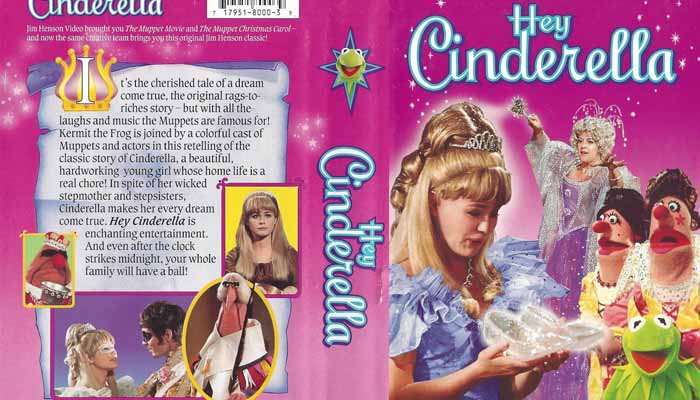
‘Hey Cinderella!’ At a Glance
| Feature | Detail | Snippets |
|---|---|---|
| Format | TV Movie / Special | |
| Runtime | 52 minutes | |
| Original Airdate (CBC) | March 16, 1969 | |
| Original Airdate (ABC) | April 10, 1970 | |
| Director | Jim Henson | |
| Writers | Jon Stone, Tom Whedon (Based on Charles Perrault) | |
| Composer | Joe Raposo | |
| Production Companies | Muppets, Inc. (Henson Associates), Robert Lawrence Productions | |
| Key Muppet Performers | Jim Henson, Frank Oz, Jerry Nelson | |
| Key Human Stars | Belinda Montgomery, Robin Ward, Joyce Gordon, Pat Galloway | |
| Puppet Maker | Don Sahlin | |
| Filming Location | Toronto, Ontario, Canada |
Why ‘Hey Cinderella!’ Matters – Henson History in the Making
Though filmed before Sesame Street debuted, Hey Cinderella! aired on ABC in the US in April 1970, after the groundbreaking children’s show had already premiered. This timing led to at least one amusing anecdote: a critic accused Henson of “selling out” Sesame Street by featuring Kermit on a commercial network special, unaware the special predated Kermit’s Sesame Street appearances and was filmed entirely independently. Beyond such trivia, Hey Cinderella! holds profound significance in the Muppet canon for several key reasons.
First and foremost, it was Kermit’s defining moment. By giving him his definitive frog design and a central, reasoning personality, the special set Kermit on the path to becoming the Muppets’ anchor and Henson’s most enduring alter ego. Without the frog we meet in Hey Cinderella!, the history of the Muppets might look very different.
Secondly, it was the seed for Sesame Street‘s Muppet magic. The special (and its 1965 pilot precursor) marked the crucial first major collaboration between Jim Henson, writer Jon Stone, and composer Joe Raposo. This creative triumvirate honed their working relationship here, developing the blend of humor, character, and music that would become synonymous with the Muppets on Sesame Street. Stone, deeply impressed by Henson’s genius during their Cinderella work, was instrumental in recruiting him for the Children’s Television Workshop project. Raposo, of course, went on to write countless iconic Sesame Street songs, including Kermit’s anthem, “Bein’ Green”. Hey Cinderella! served as the proving ground where this legendary partnership first truly sparked.
Thirdly, Hey Cinderella! established the template for Muppet fairy tales. As the first of the Tales from Muppetland specials (followed by The Frog Prince and The Muppet Musicians of Bremen), it pioneered the format of taking a classic story and retelling it with Muppet wit, charm, and unexpected twists. This approach – respecting the source while playfully subverting it – became a beloved Muppet tradition, echoed in countless sketches and later feature films. It helped define the “Muppet take” as a distinct narrative brand: humorous, heartfelt, and always surprising.
Finally, the special stands as a testament to Henson’s adaptability and vision. Transforming a failed series pilot into a successful stand-alone special, resourcefully integrating characters from other projects, and pushing technical boundaries with creations like Splurge all demonstrate Henson’s unique blend of creative resilience and practical ingenuity. It was an early showcase of his ability to navigate the challenges of television production while delivering entertainment that appealed across generations.
Finding Cinderella Today – Legacy and Availability
Decades after its debut, Hey Cinderella! remains a charming piece of television history, listed among notable Henson productions and fondly remembered by those who grew up with it. While detailed contemporary reviews are scarce in available records, later critical perspectives, such as that of fairy tale scholar Jack Zipes, have recognized the Muppet adaptations like Hey Cinderella! for challenging the passive roles often assigned to female characters in traditional tales, offering a more critical (though still commercial) counterpoint to interpretations like Disney’s.
The special enjoyed official home video releases in the past. Muppet Home Video issued it on VHS, Beta, and CED formats in 1983 (distributed via Walt Disney Telecommunications and RCA), and Buena Vista Home Video released it again on VHS under the Jim Henson Video label in 1994.
However, finding Hey Cinderella! through official channels today can be a challenge. It is notably absent from major streaming platforms like Disney+, a situation common for much pre-Disney acquisition Muppet material. Complex rights issues, often involving music or co-production partners (like Canada’s Robert Lawrence Productions in this case), frequently hinder the re-release of older Muppet specials and series. This scarcity makes specials like Hey Cinderella! something of a hidden gem for dedicated fans. Fortunately, for those eager to experience this early Muppet delight, the special is currently available for free viewing and download on the Internet Archive. This contrasts with the even rarer 1965 pilot, which, since its rediscovery, is only accessible for viewing at The Paley Center for Media in New York.
Conclusion – A Foundational Fairy Tale
Hey Cinderella! is more than just a footnote in Muppet history; it’s a vibrant, funny, and genuinely magical television special that encapsulates the essence of Jim Henson’s early creative vision. Its witty script, endearing performances from both human and Muppet cast members, and clever twists on a timeless story make it a delightful watch even today.
More importantly, it stands as a crucial stepping stone. It’s where Kermit became definitively Kermit the Frog, where the foundational creative team for Sesame Street‘s Muppets first truly clicked, and where the beloved tradition of Muppet fairy tale adaptations began. The special showcases Henson’s burgeoning genius – his ability to blend sophisticated humor with genuine heart, appealing to children and adults alike, and his relentless drive to innovate in the art of puppetry. For anyone wishing to understand the roots of the Muppet phenomenon, seeking out Hey Cinderella! (perhaps via the Internet Archive ) offers a rewarding glimpse into the moment Jim Henson’s extraordinary creative universe truly began to expand. It’s a charming reminder that even before the rainbow connection, the magic was already there.

